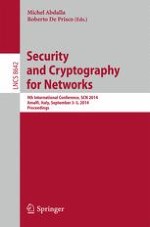This book constitutes the proceedings of the 9th International Conference on Security and Cryptography, SCN 2014, held in Amalfi, Italy, in September 2014. The 31 papers presented in this volume were carefully reviewed and selected from 95 submissions. They are organized in topical sections on key exchange; multilinear maps and obfuscation; pseudorandom function extensions; secure computation - foundations and algorithms; network security; functional encryption; cryptanalysis; secure computation - implementation; zero knowledge; message authentication; proofs of space and erasure; public-key encryption.
